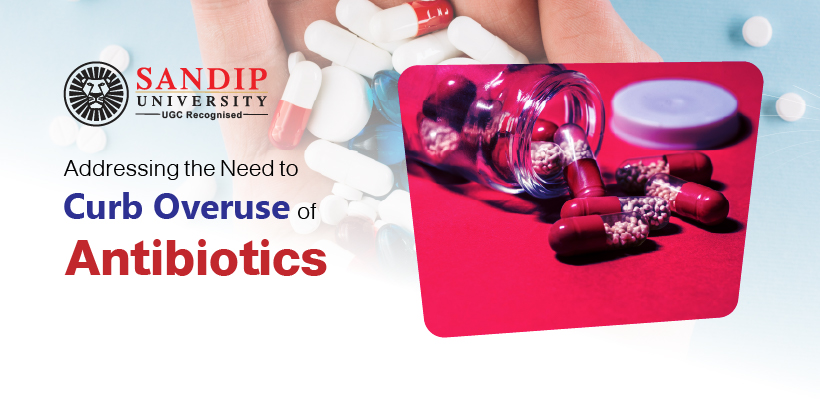Antimicrobial Resistance (AMR)
In recent times it has become fashionable for most medical practitioners to prescribe antibiotics if any patient approaches them for small infections like common cold or flu. These infections are produced by various microorganisms like bacteria, viruses, fungi and parasites. Although antibiotics are the useful tool to deal with these microorganisms, the usefulness of antibiotics can be worsened if not administered as per the prescription. Some of the top pharmaceutical science colleges in Nashik are conducting research into antimicrobial resistance in humans and its long-term effects.
The inappropriate use of antibiotics leads to adaptation in microorganisms, and because of that, they persist in the human body and cause serious infections. These microbes have a smart strategy to take advantage of this. They produce strains that deceive the antibiotics by cleverly changing themselves (mutation). In short, their younger generations are bold and resistant. This mutation leads to a decrease or complete loss of antibiotics’ effectiveness. We call this antimicrobial resistance.
Mechanism of AMR
When it’s necessary, a lot of patients don’t finish the whole course of treatment. For instance, a lot of patients stop taking their medicine a day or two early because they start to feel better when a doctor tells them to take it for five days. They don’t understand that feeling better doesn’t mean they are fully healed. They need to finish the whole course in order to get rid of all the microbes. If not, resistant bacteria can grow and diminish the effect of antibiotics that were previously effective against the microorganism. The developed resistance results in the utilisation of more strong and dangerous antibiotics that may lead to serious side effects inside the human body. Besides these resistance species spread across the society and make it a public health issue. The overuse of antibiotics fasten the process of microorganisms to become resistant. The survey has shown that resistance usually develops within six months of an antibiotic being released in India.
Types of AMR
There are two types of antibiotic resistance, extrinsic (acquired) and intrinsic. When people talk of drug resistance, they usually mean extrinsic resistance. When a medicine is ineffective against a particular microorganism due to inherent traits in that microbe, this is known as intrinsic resistance. For instance, the cell wall of a specific type of bacterium (plural: bacteria) may be able to keep out specific drugs. Extrinsic resistance occurs when a medication that was once successful against a certain microorganism has developed a mutation that renders the medication ineffective. These alterations can be transmitted by microbes during reproduction.
Why does AMR Need to be Stopped?
AMR is a global concern related to public health as it threatens the advancement in the medical field. It needs to be addressed in a timely manner because it may lead to the spread of infection in situations like heart surgery, cesarean sections, and hip and knee replacements. Antimicrobial resistance prolongs a person’s suffering by making infection treatment more challenging. An extended hospital stay could be the outcome of this.
How can we Stop Antimicrobial Resistance?
1. Provide Proper Training to Healthcare Professionals: Many healthcare professionals don’t have sufficient knowledge to prevent AMR. Hence, the standards and policies should be set worldwide, and proper education needs to be given to all the health workers related to the proper use of antibiotics Guidelines have been released by the WHO to encourage health workers’ education and training on antimicrobial resistance.
2. Appropriate Communication: To increase cognizance amongst society, the communication specialists, like social workers and healthcare professionals, should create three or four core messages instead of transmitting a lot of information that is pertinent to the national interest.
3. Constructing Universal Guidelines: Poor monitoring of the pharmaceutical supply chain and a shortage of strong regulations related to the safer use of antibiotics are also reasons for developing antimicrobial resistance in humans. Hence, universal guidelines should be constructed to monitor the supply and use of antibiotics.
4. Conducting Advanced Research: Researchers from all across the world have concentrated on creating novel antibiotics and repurposing medications. Scientific research is being funded by international non-profit partnerships to create new therapies, especially for use in low- and middle-income nations. Scientists are now able to quickly identify novel variants due to the sophisticated genome sequencing facilities. Because water bodies are used to dispose of a lot of waste from the production of antibiotics, scientists have also found that they serve as a major vector for the spread of Antimicrobial resistance.
5. Spreading Awareness in Public: Raising awareness of the effects of Antimicrobial resistance among the general public and other stakeholders is the most crucial step in reducing this issue. Antimicrobial resistance in the global context could also be avoided with improved management of currently available antibiotics and suitable education and training for medical personnel. A good monitoring system finds new superbugs and helps stop them from spreading around the world. More studies and surveillance have been suggested for the early detection of bacteria with antibiotic resistance in light of the fast-changing climate and its connection to antimicrobial resistance. Manufacturers must guarantee the safety, security, transparency, and adherence to specified criteria of the antibiotic supply chain.
Conclusion
The excessive use of antibiotics is detrimental to human health in the long run. It is imperative that the medical fraternity understands this danger and works towards ensuring that the antibiotic epidemic can be curtailed before it is too late. Professionals who want to build a career in pharmacy can study the long-term effects of antibiotic resistance in humans to bring about positive changes in the pharmaceutical industry.

